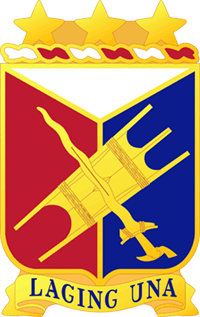History of the U.S. Army's
1st Filipino Regiment and
2d Filipino Battalion (Separate)


Filipino Regiment's Distinctive Unit Insignia
Following the Japanese attacks that destroyed U.S. airfields on Luzon on 8 December 1941, thousands of Filipinos fought side by side with U.S. Army soldiers in the defense of the Philippines. Yet at the same time stateside recruiters refused to enlist Filipino-American volunteers due to their status as American nationals. Under the Selective Service and Training Act, American nationals were ineligible to serve in the Armed Forces of the United States.
To fight a world war, however, the nation needed to call upon all its available manpower. On 21 December 1941 Congress amended the Selective Service and Training Act to permit enlistment of citizens and “every other male person residing in the United States.” As a result, on 19 February 1942, Secretary of War Henry L. Stimson announced the creation of a Filipino battalion to enable Americans of Filipino ancestry as well as resident Filipinos to serve together in the U.S. Army.
On 1 April 1942 the War Department activated the 1st Filipino Battalion. Its existence proved short-lived. In July 1942 the soldiers transferred to the newly constituted 1st Filipino Regiment which replaced the battalion, and the new regiment activated on 13 July 1942 at Salinas, California. On 14 October 1942 the Army constituted a second regiment, designated as the 2d Filipino Regiment. The 1st Battalion, 2d Filipino Regiment, activated on 22 October 1942 at Fort Ord, California.
Shortly thereafter, the Office of The Adjutant General approved a coat of arms for the 1st Filipino Regiment. The red, white, and blue colors on the shield, representing the national colors of the Philippines and the United States, reflected the Filipino heritage of this U.S. Army regiment. The unit was granted the motto LAGING UNA, which is “Always First” in Tagalog—a major native language of the Philippines. No records have surfaced to indicate that the Army ever authorized a coat of arms for the 2d Filipino Regiment.
On 27 March 1944 the 2d Filipino Regiment was disbanded, and the 1st Battalion was concurrently reorganized and redesignated as the 2d Filipino Battalion (Separate). From Fort Ord, elements of the 1st Filipino Regiment and the 2d Filipino Battalion (Separate) moved to various training locations in California before embarking separately at San Francisco for a two-week voyage to the South Pacific.
Elements of the 1st Filipino Regiment arrived in New Guinea in April 1944 where they fought until moving to the Philippines in February 1945. There, some of the regiment’s companies provided security for Eighth Army General Headquarters, Far East Air Force, and Seventh Fleet Headquarters as well as at two airstrips, Tanauan and Tacloban. For the remainder of the war, the 1st Filipino Regiment manned checkpoints, participated in mopping-up operations, and performed security and support operations in the Philippines. The unit returned to the United States in March 1946 and inactivated at Camp Stoneman, California, on 10 April 1946. The 1st Filipino Regiment earned battle honors for New Guinea, Leyte, and the Southern Philippines. The unit additionally earned the Philippine Presidential Unit Citation.
The 2d Filipino Battalion (Separate) left the United States in June 1944 and arrived in New Guinea in July 1944. The battalion eventually moved to Manila, Philippine Islands, where it inactivated on 21 December 1945. The unit earned battle honors for New Guinea. It did not receive any decorations.
- Additional Resources and Information
- “1st Filipino Infantry” [PDF 19MB]
A Year Book depicting the 1st Filipino Regiment’s training in California. - Statements of Service
- 1st Filipino Regiment Distinctive Unit Insignia and Coat of Arms
(courtesy of The Institute of Heraldry) - Service Summaries
Includes unit stations, assignments, and campaign credit. - World War II Campaign Pamphlets
- 1st Filipino Regiment Stations [PDF 7MB]
A Year Book depicting the 1st Filipino Regiment’s training in California
Note to Researchers: The above list of stations is organized by companies. It was assembled from information in unit Morning Reports. - Resources and Research section on World War II - Asiatic-Pacific Theater